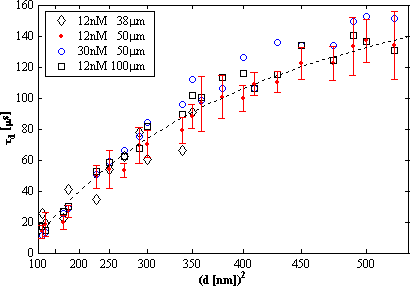
EPFLSTILOBMarcel LeuteneggerAbout
FCS on sub-wavelength apertures
Near-field fluorescence spectroscopy
 |
EPFLSTILOBMarcel LeuteneggerAbout FCS on sub-wavelength apertures Near-field fluorescence spectroscopy |
|---|

For the observation of single molecule dynamics with fluorescence fluctuation spectroscopy (FFS) very low fluorophore concentrations are necessary. For in vitro measurements, this requirement is easy to fulfill. In biology however, micromolar concentrations are often encountered and may pose a real challenge to conventional FFS methods based on confocal instrumentation. We show a higher confinement of the sampling volume in the near-field of sub-wavelength sized apertures in a thin gold film. The gold apertures have been measured and characterized with fluorescence correlation spectroscopy (FCS), indicating light confinement beyond the far-field diffraction limit. We measured a reduction of the effective sampling volume by an order of magnitude compared to confocal instrumentation.

Figure 1: Photograph of our trans-illumination nano-aperture FCS setup.

Figure 2: Auto-correlations and fits G versus lag time τ for aperture diameters of 125nm (blue circles), 490nm (red points) and for free liquid (black dotted) at a Cy5 concentration of 30nM. Inset: Fit residuals r = Gfit/G - 1.

Figure 3: Diffusion time τd versus aperture diameter d. The data points show the average and the error bars the standard deviation of 10 measurements per aperture diameter. For clarity, the standard deviation is shown for one case only (12nM Cy5, 50µm pinhole). The black dotted line shows the trend. In free liquid, the diffusion time was 160µs to 170µs. Inset: concentration of Cy5 and pinhole diameter of all cases.
We demonstrated that FCS on single apertures is an interesting approach for molecular investigations at 10nM to 100nM concentration. Using apertures of various sizes, we calculated and engineered the excitation field. For small apertures, we verified that the diffusion time and the number of molecules are proportional to the aperture diameter. We measured a reduction of the effective sampling volume by an order of magnitude compared to the typical volume in confocal FCS.
We thank Benjamin Dwir at EPFL for electron-beam and nanostructuring assistance.
This work was funded by the Swiss National Science Foundation (SNSF #200021-103333).
© 2011 École Polytechnique Fédérale de Lausanne